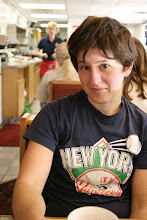 I'm making plans to take a trip up to Portland for Thanksgiving at Vanessa's house and Morgan has decided to come too. We have loose plans to drive up the coast and stay at a beach yurt in Oregon, but the biggest plan we've conceded upon is to try to not make too many plans. But the thought of trips and travel has got me looking at pictures and postcards from the trips of other people to see what they elucidate. This picture reminded me of the pictures in my grandparents' travel albums full of photographs of one or the other of them standing in front of something old, beautiful, or historically significant.
I'm making plans to take a trip up to Portland for Thanksgiving at Vanessa's house and Morgan has decided to come too. We have loose plans to drive up the coast and stay at a beach yurt in Oregon, but the biggest plan we've conceded upon is to try to not make too many plans. But the thought of trips and travel has got me looking at pictures and postcards from the trips of other people to see what they elucidate. This picture reminded me of the pictures in my grandparents' travel albums full of photographs of one or the other of them standing in front of something old, beautiful, or historically significant. It's clear to those writing about these images from outside of their experience that the tourist narrative of a place hardly aligns with the local narrative of significance. For example, when people visit Ithaca they usually make reference to 1) the view from the top of Fall Creek or Cascadilla gorge 2) the grandiose buildings of Cornell University and 3) the quaint Farmer's Market. The local narrative includes these things but is fleshed out with more-- the view from the bottom of the gorges, the winter-weathered houses near downtown, the kitchens and farms where the market food came from. It also includes lesser-known secrets-- for example, the best swimming hole is actually out at Flat Rock behind Plantations where the water is lazy or at Treman Park where you can climb up the waterfall so the high-pressure water hits you in the face or out at Taughannock where there's a million secret watery places to hide and feel like you're totally alone. There's the secret path along the train tracks from the high school and the short-cut across the golf course to the lighthouse pilings.
Certainly my grandparents saw a lot of things on their travels, but how much did they really see and what did they miss out on entirely? Morgan and I will start driving in the afternoon when she gets off work so that by the time we get to the redwoods they'll be lost in the night time. But it's also important to point out that we'll be driving up the coastal micro-climate-- if you were to travel 50 miles inland the states of California and Oregon turn into completely different places, stretching vastly towards the east into plains and forests and desert and mountains. There's much that we will not see but certainly much to remember. I imagine the woman in this picture remembers much more about the person taking her picture than the arch she's standing under.

No comments:
Post a Comment